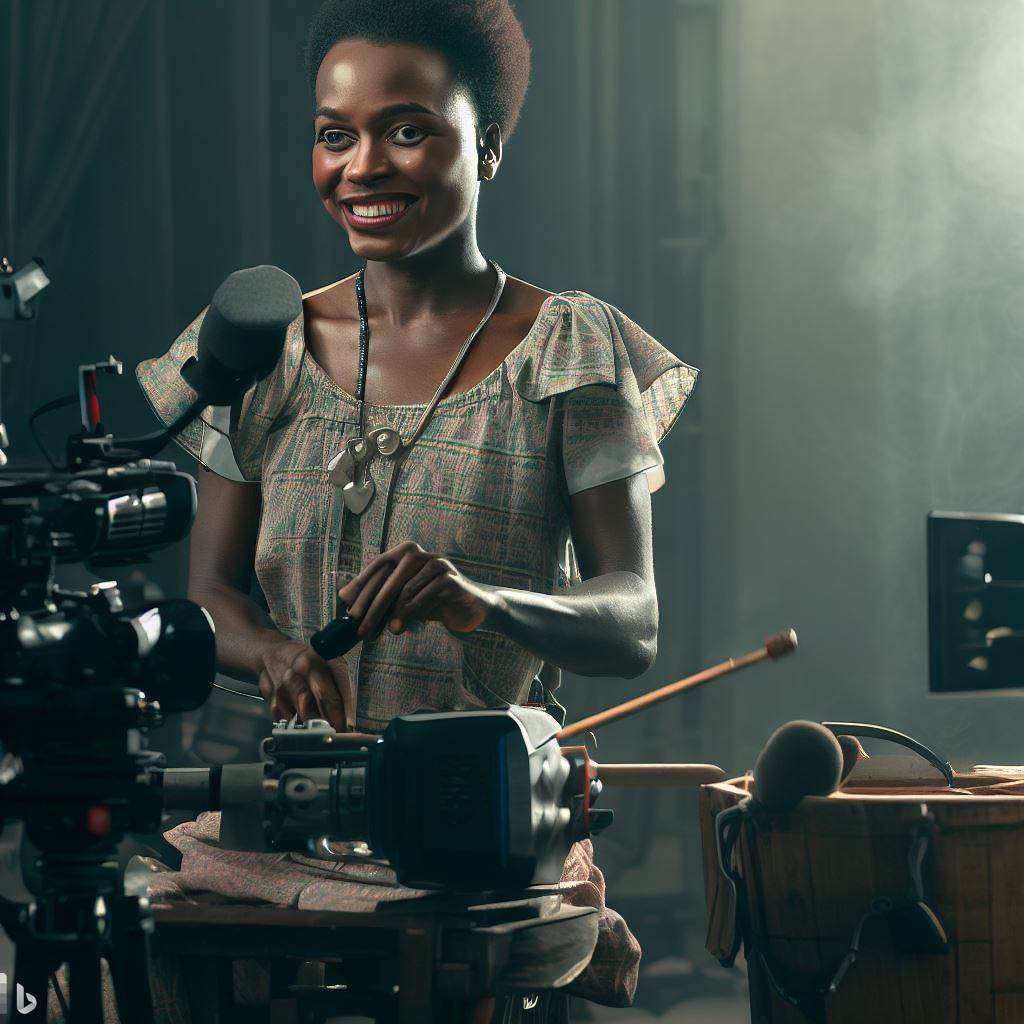Introduction
Foley artistry plays a significant role in Nigeria’s flourishing film industry, known as Nollywood. This posts discusses The Hidden Foley Artistry Profession Boosting Nigeria Film Success
This behind-the-scenes profession is often overlooked but greatly contributes to the overall quality and success of Nigerian films.
Foley artistry involves creating and recording sound effects that synchronize with the actions and movements in a film.
These sounds, such as footsteps, the rustling of clothes, or the clinking of cutlery, add authenticity and depth to the on-screen experience.
They bring the film to life and immerse the audience in the story, enhancing their emotional connection and engagement.
Foley artists meticulously study film scenes to create sounds that perfectly match each action.
“Hidden Foley Artistry Profession Boosting Nigeria Film Success” encapsulates the silent yet impactful role that Foley artists play in enhancing the success of Nigerian films.
The importance of their work cannot be overstated, as it adds an extra layer of realism and enhances the overall auditory experience.
Foley artistry helps to create a seamless and immersive audiovisual narrative, elevating the quality of Nigerian films and making them more enjoyable for viewers.
Foley artistry, a concealed craft, crucial for Nollywood’s triumph, merits acknowledgment for fostering its progress and expansion in Nigeria’s film sector.
Overview of Foley Artistry
Foley artistry is a captivating and often overlooked profession in the world of filmmaking. It plays a crucial role in creating a realistic cinematic experience by adding sound effects to films.
The phrase “Hidden Foley Artistry Profession Boosting Nigeria Film Success” succinctly captures the behind-the-scenes art form that contributes to the triumph of Nigerian cinema.
Foley artists use their artistic skills to recreate and enhance sounds that are not captured during filming, bringing the on-screen action to life.
This blog section defines foley artistry and its purpose, explores sound effect creation, and emphasizes foley’s vital role in film success.
Foley Artistry and its Purpose in Filmmaking
Foley artistry can be defined as the art of creating and adding sound effects to films during post-production.
Transform Your Career in Nigeria
Discover unmatched expertise with our personalized Career Consulting service. Navigate Nigeria’s job market with a strategy tailored just for you.
Get StartedIt involves the reproduction or creation of sounds that synchronize with the on-screen actions, providing a more immersive experience for the audience.
The purpose of foley artistry is to enhance the realism of a film by filling in the gaps where natural sounds were either not captured or are insufficient.
Foley artists are responsible for creating a range of sounds, including footsteps, door creaks, gunshots, and vehicle sounds, among others.
How Foley Artists Create and Add Sound Effects to Films
Foley artists employ a variety of techniques and props to create sound effects that match the visual elements of a film.
They closely watch the film scenes and meticulously perform the necessary actions to produce the desired sound.
For example, to recreate footsteps on different surfaces, foley artists may use different shoes or materials to achieve the distinct sounds.
They employ items: coconut shells imitate horse trotting, celery for bones cracking, wallets with change replicate money exchange.
These actions are timed precisely to match the exact timing of the on-screen actions, ensuring seamless integration between sound and visuals.
Role of Foley Artistry in Creating a Realistic Cinematic Experience
Foley artistry plays a crucial role in creating a realistic cinematic experience by enhancing the audio aspect of a film. It helps to create a more immersive and emotionally engaging experience for the audience.
Foley artists focus on every detail, ensuring that the sounds they create match the visual cues and enhance the storytelling.
Their work adds depth and authenticity to the film, making the audience feel present in the on-screen world.
Whether it’s the sound of rain pouring, a glass breaking, or a suspenseful silence, foley artistry enhances the overall atmosphere and emotional impact of the film.
In the end, foley artistry is a hidden profession that significantly contributes to Nigeria’s film success.
By defining foley artistry and explaining its purpose in filmmaking, we have shed light on the importance of this profession.
Foley artists’ ability to create and add sound effects to films using various techniques and props is remarkable.
Their work plays a vital role in creating a realistic cinematic experience by enhancing the audio aspect of a film.
So, the next time you watch a movie, take a moment to appreciate the artistry behind the sounds that bring the film to life.
Read: Prominent Nigerian Films and the Foley Artistry Behind Them
The Evolution of Foley Artistry in Nigeria
When discussing the success of Nigeria’s film industry, popularly known as Nollywood, one cannot overlook the crucial role played by foley artistry.
Through the “Hidden Foley Artistry Profession Boosting Nigeria Film Success,” skilled sound engineers bring depth and authenticity to the auditory aspects of Nigerian movies.
Foley artistry, also referred to as sound effects editing, is a hidden profession that has significantly boosted the quality and success of Nigerian films.
Let’s delve into Nigeria’s film industry’s foley art origins, address early artist challenges, and spotlight recent growth and recognition.
Roots of Foley Artistry in Nigeria’s Film Industry
- Nigeria’s film industry has a rich history dating back to the 1960s, but foley artistry was not initially a prominent aspect of the filmmaking process.
- Early Nigerian filmmakers primarily focused on storytelling and capturing visuals, neglecting the importance of sound and sound effects.
- It was not until the 1990s that foley artistry gained recognition in Nigeria’s film industry, thanks to pioneers like Samson Adesiyan and Eniolorunopa Adesiyan.
- These pioneers introduced innovative techniques from Hollywood and began experimenting with creating sound effects to enhance the overall cinematic experience.
Challenges Faced by Early Nigerian Foley Artists
- During its early stages, foley artistry in Nigeria faced numerous challenges, including limited resources and a lack of understanding of its significance.
- Nigerian foley artists often had to be resourceful and creative, using everyday objects to produce sound effects due to the lack of specialized equipment.
- Moreover, there was a significant lack of awareness and appreciation for foley artistry, with filmmakers and audiences primarily focusing on the visual aspects of films.
- The low budget nature of Nigerian films also hindered the growth of foley artistry, as resources were often allocated to other areas of production.
Growth and Recognition of Foley Artistry in Recent Years
- Despite the challenges, foley artistry in Nigeria has experienced significant growth and recognition in recent years.
- With advancements in technology, Nigerian foley artists now have access to specialized equipment, enhancing the quality of sound effects.
- There is a growing appreciation for the importance of sound in films, with filmmakers and audiences recognizing the impact of foley artistry on the overall cinematic experience.
- Additionally, the success of Nigerian films internationally has contributed to the recognition of foley artistry, as it has become a distinguishing factor of Nollywood productions.
In fact, the evolution of foley artistry in Nigeria’s film industry has been remarkable.
From its humble beginnings to gaining recognition and appreciation, foley artistry has played a vital role in enhancing the quality and success of Nigerian films.
Publish Your Professional Profile, Business or Brand
Showcase your expertise, gain trust, and boost visibility instantly on Professions.ng.
Publish NowThrough resourcefulness and creativity, early Nigerian foley artists overcame challenges and paved the way for future generations.
With the growth and recognition of foley artistry, Nigeria continues to solidify its position as a force to be reckoned with in the global film industry.
Read: Interviews with Successful Foley Artists in Nigeria’s Film Industry
Contributions of Foley Artistry to Nigerian Films
Enhancing Storytelling in Nigerian Films
One significant way in which foley artistry contributes to Nigerian films is by enhancing storytelling.
The seemingly concealed “Hidden Foley Artistry Profession Boosting Nigeria Film Success” resonates as an indispensable factor in the rise of Nigeria’s film industry.
Foley artists use their creative skills to bring the soundscape of a movie to life, adding depth and realism to the on-screen action.
Improving the Quality and Impact of Sound Effects in Films
Foley artists play a crucial role in improving the overall quality and impact of sound effects in Nigerian films.
They meticulously recreate or create sound effects from scratch, ensuring that every audio element matches the visual experience seamlessly.
Add Layers of Realism to Film Scenes
By adding layers of realism to film scenes through sound effects, foley artists contribute immensely to the success of Nigerian films.
Every footstep, door creak, or ambient noise is carefully crafted to enhance the viewer’s immersion in the story.
Creating Emotional Connections with the Audience
One example of how foley artistry contributes to Nigerian films is by creating emotional connections with the audience.
Whether it’s the sound of a heartfelt dialogue or the impactful sounds of a battle scene, foley artists enhance the emotional impact of any given moment.
Successful Nigerian Films Benefiting from Foley Artistry
Several successful Nigerian films have greatly benefited from the skillful work of foley artists.
“The Wedding Party,” a romantic comedy, achieved box office success by expertly crafting sound effects for comedic timing.
“King of Boys” – A Masterclass in Foley Artistry
Another example highlighting how foley artistry enhances Nigerian films is the critically acclaimed “King of Boys.”
This crime thriller brilliantly utilizes sound effects to heighten suspense, immerse the audience in the gritty world of the story, and add an extra layer of realism to intense scenes.
“The Milkmaid” – Aesthetic Immersion through Foley Artistry
“The Milkmaid,” a thought-provoking drama, showcases how foley artistry can create aesthetic immersion.
Wind rustling trees, chirping birds, and village sounds immerse the audience in rural scenes, amplifying emotional story impact.
“October 1” – Historical Accuracy through Sound Effects
“October 1” is a historical thriller that demonstrates the importance of foley artistry in achieving historical accuracy.
The film relied on expertly crafted sound effects to recreate the sounds of vintage cars, firearms, and other elements of the 1960s Nigerian setting.
Recognition and Advancement of Foley Artistry in Nigeria
With the growing success and recognition of Nigerian films globally, the role and importance of foley artistry are gaining more attention.
This has resulted in the advancement of the profession and the emergence of talented foley artists in Nigeria.
Foley artistry greatly boosts Nigerian films by enriching narratives, refining sound effects, and infusing authentic realism.
Examples like “The Wedding Party,” “King of Boys,” and “The Milkmaid” highlight the immense impact foley artistry has had on Nigerian cinema.
As the industry continues to grow, the recognition and advancement of foley artistry in Nigeria will only continue to flourish.
Read: Music Directors’ Contribution to Nigerian Cultural Heritage

The Importance of Foley Artistry in Nigeria’s Film Success
Foley artistry significantly elevates Nigeria’s film sector, amplifying global recognition, and enriching Nigerian cinema with substantial value.
“Hidden Foley Artistry Profession Boosting Nigeria Film Success” sheds light on the unheralded professionals who are instrumental in propelling Nigerian films to greater heights.
The diversity and creativity displayed by Nigerian foley artists are remarkable.
The impact of foley artistry on the Nigerian film industry’s global reputation
Foley artistry has propelled the Nigerian film industry, commonly known as Nollywood, onto the global stage.
With meticulously crafted sound effects, foley artists create an immersive experience for viewers worldwide.
These sound effects, synchronized and matched with the on-screen visuals, enhance the overall quality and realism of Nigerian films.
Nigerian films once faced resource constraints, causing low production quality and inadequate sound effects.
However, foley artistry has revolutionized the industry, allowing Nollywood to compete with international film markets like Hollywood and Bollywood.
The attention to detail and precision in sound design have earned Nigerian films recognition and acclaim from audiences and critics alike.
Foley artists expertly mimic sounds with common objects, helping Nollywood overcome budget constraints for top-notch production.
The dedication and professionalism of Nigerian foley artists have played a pivotal role in establishing Nigeria as a notable player in the global film industry.
How foley artistry adds value to Nigerian films
Foley artistry is more than just a technical aspect of filmmaking; it adds substantial value to Nigerian films in various ways:
- Realism: Foley artists bring scenes to life by creating realistic and believable sound effects. From footsteps to creaking doors, every detail contributes to the immersive experience.
- Emotional Impact: Foley artistry enhances the emotional impact of a film by intensifying and manipulating sound effects.
It helps create suspense, fear, or joy, evoking powerful responses from the audience. - Atmosphere: Foley artists use sound to establish the environment and set the mood for a scene.
Whether it’s the bustling streets of Lagos or the tranquility of a rural village, the auditory cues contribute to the overall atmosphere of the film. - Character Portrayal: Foley artistry aids in the characterization of individuals by creating unique sounds associated with specific characters.
These sounds help define personality traits and even contribute to the narrative development.
Foley artists’ precision enhances Nigerian films, gripping audiences with immersive experiences lasting beyond the film.
The diversity and creativity of Nigerian foley artists
Nigerian foley artists are masters of their craft, continually pushing creative boundaries and embracing diversity. Their ingenuity in achieving impressive sound effects is commendable.
Publish Your Professional Profile, Business or Brand
Showcase your expertise, gain trust, and boost visibility instantly on Professions.ng.
Publish NowDue to limited resources, Nigerian foley artists often resort to unconventional means to recreate sounds.
They manipulate objects and utilize their surroundings, improvising and customizing techniques to achieve desired effects.
This resourcefulness not only showcases their ability to work with constraints but also highlights their creativity and imaginative skills.
Nigerian foley artists bring cultural specificity to their work.
Incorporating distinct Nigerian sounds, traditional instruments, and local vibes, Nigerian films gain authenticity, setting them apart internationally.
The diversity within Nigerian foley artists also contributes to the vibrant and dynamic soundscape of the films.
Each artist brings their own style, expertise, and experiences to the table, enhancing the overall richness and depth of the sound design.
In a nutshell, foley artistry plays a pivotal role in the success of Nigeria’s film industry. It has not only boosted Nigeria’s global reputation but also added significant value to Nigerian films.
Nigerian foley artists creatively diversify screen sounds, captivating global audiences with unique experiences through their unparalleled craftsmanship.
Read: Nollywood and Animation: An Unfolding Narrative
See Related Content: Key Skills Every Nigerian Music Director Should Have
Challenges and Opportunities for Nigerian Foley Artists
Foley artists, essential but often unnoticed in Nigeria’s film sector, confront growth and recognition obstacles.
Limited resources and a lack of recognition pose significant hurdles for Nigerian foley artists.
Despite challenges, artists can enhance skills, leaving a mark in the industry, amidst plentiful opportunities for development.
Challenges Faced by Nigerian Foley Artists
- Limited Resources: Nigerian foley artists often struggle with limited access to high-quality equipment and props, hindering their ability to create realistic and immersive sound effects.
- Lack of Recognition: The foley profession is not widely understood or acknowledged, making it difficult for Nigerian artists to gain recognition and appreciation for their work.
- Inadequate Training and Education: Many foley artists in Nigeria lack proper training and education to refine their skills, resulting in subpar sound effects in films.
- Funding Difficulties: Securing funding for foley projects is a recurring challenge, as it is often overshadowed by other aspects of film production.
Opportunities for Foley Artists to Develop their Skills
- Collaboration with Filmmakers: Nigerian foley artists can forge partnerships with filmmakers to create sound effects that meet their vision and elevate the overall film experience.
- Access to Advanced Technology: As technology advances, foley artists can embrace new tools and software that can enhance their craft and produce higher-quality sound effects.
- Inclusion in Film Festivals and Workshops: Participating in film festivals and attending workshops provides foley artists with opportunities to network, learn new techniques, and gain exposure.
- International Collaborations: Working with foley artists from other countries can expose Nigerian artists to different styles and approaches, broadening their creative horizons.
Success Stories of Nigerian Foley Artists
Despite the challenges they face, Nigerian foley artists have managed to overcome obstacles and achieve recognition for their exceptional work.
- Emeka Anyiam: Emeka Anyiam, a talented Nigerian foley artist, earned acclaim for his work on the award-winning film “The Milkmaid.”
His attention to detail and dedication to creating authentic sound effects garnered international recognition. - Chika Anude: Chika Anude, another Nigerian foley artist, overcame limited resources by improvising with everyday objects to produce remarkable sound effects.
His work on “The Figurine” added depth and realism to the film’s audio. - Funmi Ogunja: Funmi Ogunja showcased her talent as a foley artist in the critically acclaimed film “October 1.”
Her skillful use of Foley techniques brought the film’s historical setting to life, enhancing the viewer’s experience.
These success stories illustrate that Nigerian foley artists have the potential to excel despite the challenges they face.
With recognition, support, and access to resources, they can further contribute to the success of Nigerian cinema.
Conclusion
Foley artistry plays a vital role in the success of Nigeria’s film industry. It enhances the cinematic experience by creating realistic sounds that make scenes come alive.
The contributions of foley artists cannot be overlooked, as they add depth and authenticity to the storytelling process.
They meticulously recreate sounds using various props and techniques to create a seamless audiovisual experience.
Moving forward, there is a hopeful outlook for the future of foley artistry in Nigeria’s film industry.
As the industry continues to grow and gain international recognition, the demand for high-quality sound design will only increase.
Advancements in technology and heightened sound awareness amplify the Nigerian foley artists’ potential for enhanced filmmaking roles.
Their expertise and creativity will continue to elevate Nigerian films and contribute to their success on a global scale.
Foley artistry in Nigeria is a hidden profession that deserves recognition for its significant contributions to the country’s film success.
The skill and dedication of foley artists enhance the cinematic experience and play a crucial role in storytelling.
With a bright future ahead, foley artistry will continue to thrive and shape the Nigerian film industry.




